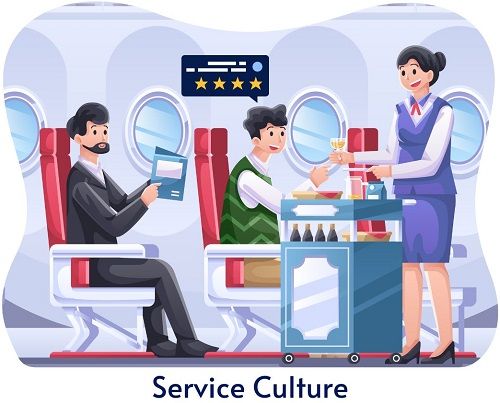Definition: Service culture is the organizational culture focused on creating values for both customers and employees. It signifies that every unit of the organization is committed to delivering superior customer service.
Majorly, it is acknowledged in customer-centric service-oriented organizations. In addition, it is also relevant for those who are curious to know customers’ demands and meet them.
Here, serving and satisfying customers is the top priority of the organization.

Organizations align their behaviour, vision, mission, rules and rewards to create solid cultural values. Consequently, the employees get motivated to deliver premium customer service. Subsequently, it improves the overall business performance.
The employees continuously try to diagnose and match customers’ perceived service quality. After each interaction, this will leave a positive imprint in the customer’s mind.
In contrast, a single negative interaction may even change the customer’s perception. Thus, every interaction with customers is vital, whether big or small. This explains the need to adopt a service culture in organizations.
They motivate their workforce to be customer oriented while performing their respective tasks.
To achieve excellence, businesses must focus on both customer service and company culture. There exists an inter-relationship between the interests of employees and customers.
The top-level management initiates the development of this culture. Further, it is cascaded down to the lower levels until operational levels. But, it requires significant time and consistency to develop such a culture.
Content: Service Culture
- What is Service?
- What is Culture?
- Customer Service Culture
- Example
- Types
- Developing a Service Culture
- Requirements
- Importance
- Internal and External Customers
- Corporate Culture v/s Service Culture
- Final Words
What is Service?
It is the action of assisting the customer with the motive of satisfying their need. It is purely customer oriented. Moreover, every business entity is directly or indirectly indulged in the service business.
To serve customers, it is essential to investigate the customer’s preferences, like:
- Professionalism
- Enthusiastic Service
- Timely Service
- Personal Recognition
What is Culture?
Culture is what an organization believes in. More precisely, it refers to the values and traditions that direct the behaviour of personnel working in the organization.
Each organization have distinguished culture. They form their norms based on their cultural beliefs and values.
Everything organizations do create culture, including:
- Things they say.
- The way they act.
- The rewards they give.
- Things they ignore.
Customer Service Culture
This concept is the same as service culture. Simply, it is the organization’s culture with customers as its top priority. The goal of an organization with such a culture is anticipating and fulfilling customers’ needs.
Here, each personnel’s priority is customers above anything else. Moreover, they are dedicated towards superior customer service. Also, they believe in the simple principle that they work for customers, not only for the company.
The following factors form an important part of the customer service culture:
- Values
- Beliefs
- Norms
- Traditions
Besides these, Reporting Structures and Work Processes are also part of the culture.
Example
Rackspace is an American cloud computing company known for its exceptional customer service culture. The employees are dedicated and up for a quick act of goodness. They have even earned various awards in this regard.
There are many such organizations successfully operating and benefitting from this culture like:
- REI
- Ritz Carlton
- Zappos
- Slack
- Wells Fargo & co.
Types
Culture always exists in organizations, whether they have created it or not. It may evolve unintentionally or created by the streamlined efforts taken by the company.
Usually, two types of cultures exist, i.e. Official Culture and Unofficial Culture.
Official Culture

It refers to those values and beliefs that the organization sets. This culture reflects the organization’s ethics and goals and is followed by everyone pervasively.
For example, a brief introduction of company policies to fresh recruits through orientation programs.
Unofficial Culture

It is a type of service culture that the organization does not create. But, created by the employees themselves over the years.
For example, employees develop their own way of handling customers in the same organization.
Developing a Service Culture
Developing a service culture is not an easy task but a strategic matter. It is developed by implementing internal marketing practices. Furthermore, it begins with the selection of the right employees.
Before creating a service culture, analyze the existing culture thereon. Check whether the organization is availing of superior services or not. In addition, learn the availability of resources for the same.
Points to remember during the development of the service culture:
- Firstly, the top management or the person responsible for creating culture must possess a holistic view towards the organization.
- Secondly, the implementation of the service strategy is equally important. Moreover, creating a team with the same mindset is a must.
The parties involved in creating and maintaining a service culture are as follows:
- Top Level Management
- Middle-level Management
- Customer Contact Employees
- Support Employees
Requirements
One must consider the points listed below during the development and maintenance of service culture:
- Recruitment of suitable and like-minded candidates.
- Retain personnel who is performing well in this culture.
- Strive to deliver quality services to customers.
- Provide necessary guidance and assistance to the people.
- Develop a suitable service strategy and organizational structure.
- Provide required training to the front-end employees.
Steps to create a Service Culture
One can follow the simple steps mentioned below to create a customer service culture:
- Analyze the existing situation.
- Hire employees suitable for this type of culture.
- Create a healthy environment for employees.
- Formulate guidelines for the entire organization.
- Work constantly towards employee engagement.
- Review and reward employees.
Importance and Challenges
Service culture is vital for organizations as employee interactions lay a huge impact. The performance and behaviour may impact profitability and sales.
It is important for organizations in the following respects:
- It increases efficiency in processes and performances.
- Helps in retaining customers and generating resales.
- A good culture builds a good reputation or goodwill in the market.
- It brings new changes within the organizations.
- It also helps differentiate the organization from its competitors.
Challenges
An organization with this type of culture may face some challenges:
- Resistance to Change: Employees may not readily accept and practice this culture easily.
- Obsolete Values: In this ever-changing economy, values may get outdated.
- Clashes: Employees’ and organizations’ beliefs may clash with each other.
Internal and External Customers
In this culture, the organization needs to take care of the Internal and External Customers.
Internal customers are those who work for the company (Employees). External customers are the ones for whom the organization operates (Buyers).
Employees are the intermediary between the customer and the organization. In addition, they are the ones who know the customer’s in and out.
Therefore, along with customers, the organization must emphasise employee satisfaction and experiences. As, they are the face of the organization. Through this, they will get self-motivated and perform to their best capabilities.
Corporate Culture v/s Service Culture
Each organization have some kind of culture, be it corporate or service. The only difference is that in corporate culture, policies and procedures are directed towards their vision and mission. Whereas, in service culture, the company follows one norm religiously, i.e. premium customer service.
Final Words
To sum up, organizations must create a culture focused on customer service. Once achieved, it needs to be maintained regularly. This is because, after a while, employee’s enthusiasm may go down.
Leave a Reply